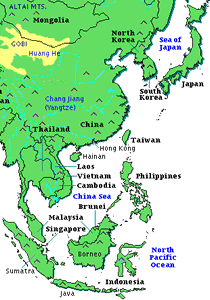
Sino-Tibetan Language Family
The Sino-Tibetan language family is one of the largest in the world. It is second only to the Indo-European language family in terms of number of speakers. The family consists of 403 highly differentiated languages with a vast geographical spread, great linguistic complexity, and a long historical record.
As the name itself implies, this family consists of two main branches:
The Sino– part of the name refers to the various Chinese (Sinitic) languages sometimes referred to as dialects. The Chinese (or Sinitic) branch has over 1.3 billion speakers, the largest number of speakers of any language branch in the world.
The Tibeto-Burman part of the name refers to 389 languages spoken over a wide area from the Tibetan plateau in the north to the Malay 
The ancestral Proto-Sino-Tibetan language is thought to have originated somewhere in the Himalayan plateau, the source of the great rivers of East and Southeast Asia, including the Yellow, Yangtze, Mekong, Brahmaputra, and Irrawaddy. Scholars hypothesize that this ancestral language split into Proto-Chinese and Proto-Tibeto-Burman around 4,000 BC.
While the Chinese branch is fairly well established, the Tibeto-Burman branch remains relatively under-explored, and there is no reliable classification for the genetic relationships among its various sub-branches. It is not possible to say exactly how many Tibeto-Burman languages there are, how many of them are separate languages or dialects of one language, or even if there are still languages belonging to that branch which have yet to be discovered and described.
Click here to view the Sino-Tibetan family tree.
The languages in the Chinese branch have a large number of speakers, while languages in the Tibeto-Burman branch include many with a small number of speakers. Over one hundred Tibeto-Burmese languages, all spoken by fewer than 1,000 people, are endangered or on the brink of extinction. Several are already extinct.
The largest languages of the Sino-Tibetan family are listed In the table below, based on Ethnologue.
|
Chinese branch (14) |
|||||
|---|---|---|---|---|---|
| Mandarin | 874 million | China | |||
| Wu (Shanghainese) | 77 million | China | |||
| Yue (Cantonese) | 71 million | China | |||
| Min Nan (Taiwanese) | 46 million | China, Taiwan | |||
| Jinyu | 45 million | China | |||
| Xiang | 36 million | China | |||
| Hakka | 30 million | China | |||
| Gan | 21 million | China | |||
| Min Bei | 10.3 million | China | |||
| Ming Dong | 9.1 million | China | |||
| Pu-Xian | 2.6 million | China | |||
|
Tibeto-Burman Branch (389)
|
|||||
|
Bai (3)
|
|||||
| Bai Central, Bai Northern, Bai Southern | 1.2 million | China | |||
|
|
|||||
|
Mahakiranti (51)
|
|||||
| Magar (3) | 500,000 | Nepal | |||
| Kham (4) | 69,500 | Nepal | |||
| Chepang (3) | 44,000 | Nepal | |||
| Sunwari (2) | 29,000 | Nepal | |||
|
Kiranti (37)
|
|||||
| Eastern (27) | 932,000 | Nepal, India | |||
| Western (9) | 52,000 | Nepal | |||
| Newari (1) | 825,500 | Nepal | |||
|
Tibeto-Kanauri (93) |
|||||
| Lepcha (1) | 76,000 | India | |||
|
Tibetic (71) |
|||||
| Bodish (1) | 143,000 | Bhutan | |||
| Dhimal (2) | 37,000 | Nepal, Darjeeling District of West Bengal, India | |||
| Tamangic (15) | 1.4 million | Nepal | |||
|
Tibetan (53) |
|||||
| Central (19) | 1.99 million | China, Nepal, India | |||
| Eastern (8) | 93,000 | Bhutan | |||
| Northern (4) | 2.3 million | China | |||
| Southern (12) | 362,000 | Bhutan, China, Nepal, India | |||
| Western (6) | 538,000 | India, China, Pakistan | |||
|
Western Himalayish (20) |
|||||
| Almora (4) | 6,600 | India | |||
| Eastern (2) | 21,000 | Nepal | |||
| Janggali (1) | 23,000 | Nepal | |||
| Kanauri (12) | 81,000 | Nepal, India | |||
|
|||||
|
JIngpho-Luish (4)
|
|||||
| Jingpho (3) | 940,000 | Myanmar, India | |||
| Luish (1) | 129,000 | Myanmar | |||
|
Konyak-Bodo-Garo (21)
|
|||||
|
Bodo-Garo (13)
|
|||||
| Bodo (7) | 1.6 million | India | |||
| Garo (2) | 582,000 | India, Bangladesh | |||
| Koch (4) | 162,000 | India | |||
|
Konyak (8)
|
355,000 | India, Myanmar | |||
|
Karen (20) |
|||||
| Pa’o (1) | 561,000 | Myanmar | |||
| Pwo (4) | 1.3 million | Myanmar, Thailand | |||
|
Sgaw-Bghai (14) |
|||||
| Bghai (5) | 77,500 | Myanmar | |||
| Brek (1) | 16,600 | Myanmar | |||
| Kayah (5) | 499,000 | Myanmar | |||
| Sgaw (3) | 1.3 million | Myanmar | |||
|
Kuki-Chin-Naga (74) |
|||||
|
Kuki-Chin (49)
|
|||||
| Central (10) | 782,000 | India, Myanmar, Bangladesh | |||
| Northern (26) | 862,00 | India, Myanmar | |||
| Southern (13) | 396,000 | India, Myanmar, Bangladesh | |||
|
Naga (25) |
|||||
| Angami-Pochuri (9) | 467,000 | India | |||
| Ao (4) | 297,000 | India | |||
| Tangkhul (3) | 153,000 | India | |||
| Zeme (8) | 201,000 | India | |||
|
Lolo-Burmese (73) |
|||||
|
Burmish (14)
|
|||||
| Northern (6) | 239,000 | China, Myanmar | |||
| Southern (7) | 34.5 million | Myanmar | |||
|
Loloish (57) |
|||||
| Northern (27) | 4.8 million | China | |||
| Southern (19) | 1.3 million | China, Laos, Myanmar, Thailand | |||
|
Naxi (1)
|
309,000
|
China
|
|||
| Meitei (1) | 1.3 million | India | |||
| Mikir (2) | 603,000 | India | |||
| Mru (1) | 81,000 | Bangladesh | |||
|
Northern Assam (13) |
|||||
| Deng (2) | 1,000 | China | |||
| Tani (11) | 978,000 | India | |||
|
Nungish (5) |
139,000
|
China, Myanmar
|
|||
|
Tangut-Qiang (15) |
|||||
| Qiangic (11) | 242,000 | China | |||
| Gyarong (4) | 175,000 | China | |||
|
Tujia (2) |
71,500
|
China
|
|||
Status
The following Sino-Tibetan languages enjoy official status.
| Mandarin | People’s Republic of China, Republic of China (Taiwan), and Singapore |
| Burmese | Myanmar |
| Tibetan | Tibetan Autonomous Region and Tibetan Autonomous Prefectures in People’s Republic of China along with Mandarin. |
| Dzongka | Bhutan |
| Tamang | One of tne official languages of Nepal. |
Dialects
Sino-Tibetan languages have a complex dialect picture. Much of the difficulty is in deciding whether the varieties are separate languages or dialects of the same language. For instance, some consider varieties of Chinese dialects, while others call them languages. Tibetan has several distinct spoken varieties that are in many instances not mutually comprehensible but that have over the centuries maintained a common literary tradition, much like Chinese. Moreover, the boundaries between Tibetan and certain other Himalayan languages are sometimes unclear. In general, the dialects of central Tibet and nearby areas are considered Tibetan dialects, while other varieties such as Dzongkha, Sikkimese, Sherpa, and Ladakhi, are considered closely-related but separate languages. In practice, however, as with all languages, making a clear distinction between languages versus dialects is extremely difficult.
Structure
Sound system
The sound systems of Sino-Tibetan languages share several common features. On the whole, they have a relatively simple syllabic structure, although Chinese languages generally have a relatively simply syllabic structure, than Tibeto-Burmese languages. There are no consonant clusters, and only a few consonants, mostly nasals, can occur in syllable-final position.
Vowels
Most Sino-Tibetan languages have between six and eight vowels. Many have a contrast between unrounded and rounded front vowels, e.g., /i/ (as in bit) and /y/ (as the second vowel in statue).
Consonants
The consonant systems of Sino-Tibetan languages are characterized by a contrast between unaspirated and aspirated voiceless stops and affricates, e.g., /p – pʰ/, ts – tsʰ/.
Tones
Many Sino-Tibetan languages are tonal. The number of tones varies from language to language. There are two tones in Tibetan, three tones in Burmese, four in Mandarin Chinese, and up to nine in Cantonese. There are also many non-tonal Tibeto-Burmese languages.
Grammar
Chinese branch
- Members of this branch tend to be analytic. In an analytic language words are not inflected to show grammatical relations. The latter are expressed through word order and various particles.
- They also tend to use numerous classifiers in counting nouns.
- Chinese is a topic-prominent language. This means that the topic of the sentence, defined as ‘old’ or ‘known’ information, precedes ‘new’ or ‘added’ information.
Tibeto-Burman branch
- With the exception of Karen languages, all Tibeto-Burman languages are agglutinative languages that use post-positions to mark grammatical relationships.
- Most use nominal classifiers when counting or quantifying nouns.
- The normal word order is Subject-Object-Verb.
Vocabulary
Chinese branch
Most Chinese words are made up of one or two morphemes. The most common morphological devices in Chinese is use of compounds and derivational morphemes. Chinese tends not to borrow words from other languages. Instead, it uses native elements to create words for expressing new concepts, e.g., telephone is dyàn-huà ‘electricity + speech,’ airplane is fēi-jī ‘fly + machine,’ radio is shòu-yīn-jī ‘receive + sound + machine.’
Tibeto-Burmese branch
The majority of Burmese vocabulary is of Tibeto-Burmese stock. Different languages show different influences, depending on the country in which they are spoken and their history. For instance, Burmese has been influenced by Pali, English, and Mon, and to a lesser extent, by Chinese. Dungan has many Russian loanwords. Bodo has borrowed words from Assamese. Garo has many Bengali loanwords.
Writing
Sino-Tibetan languages are written with a variety of scripts. Below are some examples.
| Chinese | Characters | |
| Burmese | Myanmar script | |
| Tibetan | Tibetan script | |
| Lepcha | Lepcha script | |
| Newar | Ranjana script | x |
Difficulty
 How difficult is it to learn Sino-Tibetan languages?
How difficult is it to learn Sino-Tibetan languages?Mandarin and Cantonesebelong to Category III, Burmese belongs to Category II in terms of difficulty for speakers of English. No data is available for the other languages.